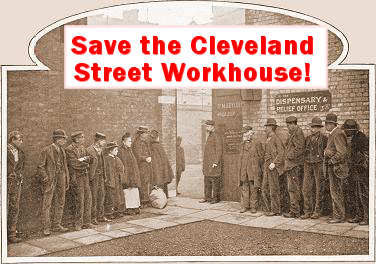Save the Cleveland Street Workhouse
 This building in Cleveland Street in Central London was originally erected in 1778 as a parish workhouse for St Paul, Covent Garden. In 1836 it was taken over by the new Strand Poor Law Union, and later became an infirmary for the Central London Sick Asylum District. It was used until recently as an out-patients annex for the Middlesex Hospital but is now empty and under threat of demolition.
This building in Cleveland Street in Central London was originally erected in 1778 as a parish workhouse for St Paul, Covent Garden. In 1836 it was taken over by the new Strand Poor Law Union, and later became an infirmary for the Central London Sick Asylum District. It was used until recently as an out-patients annex for the Middlesex Hospital but is now empty and under threat of demolition.
During its unparalleled 230 years of service to London's sick, the workhouse was closely involved in pivotal developments in the evolution of health care. A vigorous campaign to preserve this unique building is now underway. Why is the Cleveland Street Workhouse Important? The Cleveland Street workhouse is of particular significance because:
- The workhouse's medical officer Dr Joseph Rogers was a leading light in the successful campaign to improve the appalling medical conditions which existed in most of the capital's workhouses.
- Visits to the Cleveland Street workhouse also provoked Louisa Twining to found the Workhouse Visiting Society and fight for improved conditions for workhouse inmates, especially those who had no visitors.
- The workhouse in Dickens' Oliver Twist was probably based on the institution.
- The building continuously provided welfare and medical care for 230 years.
- The site is almost the last workhouse building that survives in central London and is of considerable architectural and historical value.
- Its preservation would be a fitting testament to so many of the nation's poor whose lives were dominated by the poor law system right up until the foundation of the National Health Service in 1948.
- English Heritage has already supported a listing proposal for the site but it was overturned by a minister in the last government.
For a more detailed history of the workhouse see the Strand Union web page and the article by Ruth Richardson and Brian Hurwitz. The organisation SAVE Britain's Heritage has written a powerful letter of protest. The British Medical Journal has also carried an article backing preservation of the building. Please visit www.workhouses.org.uk to see how you can help save this unique building. All responses will be of value but letters from Dickensians abroad will be of especial weight with the government department concerned, and with the planning authority.
- Created on .